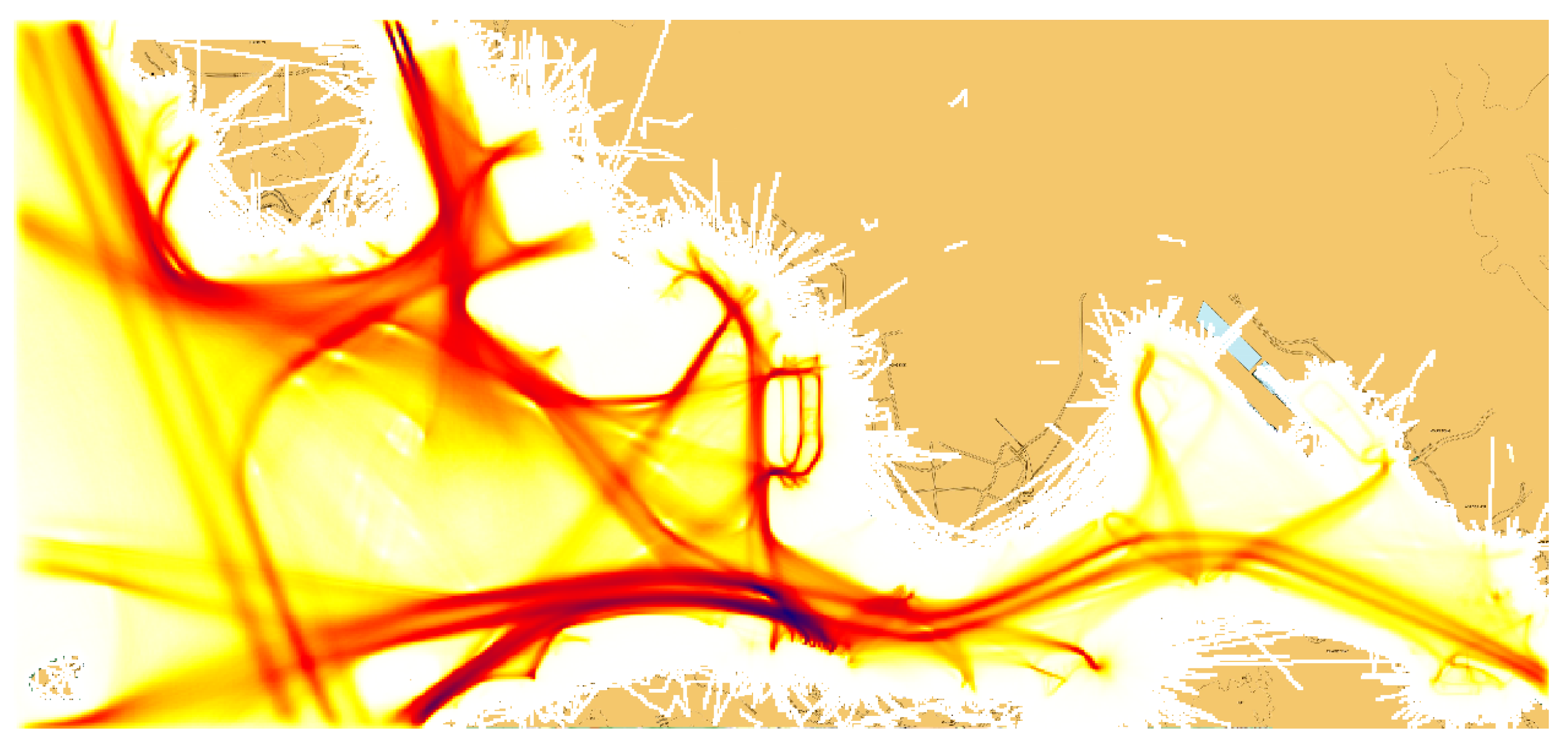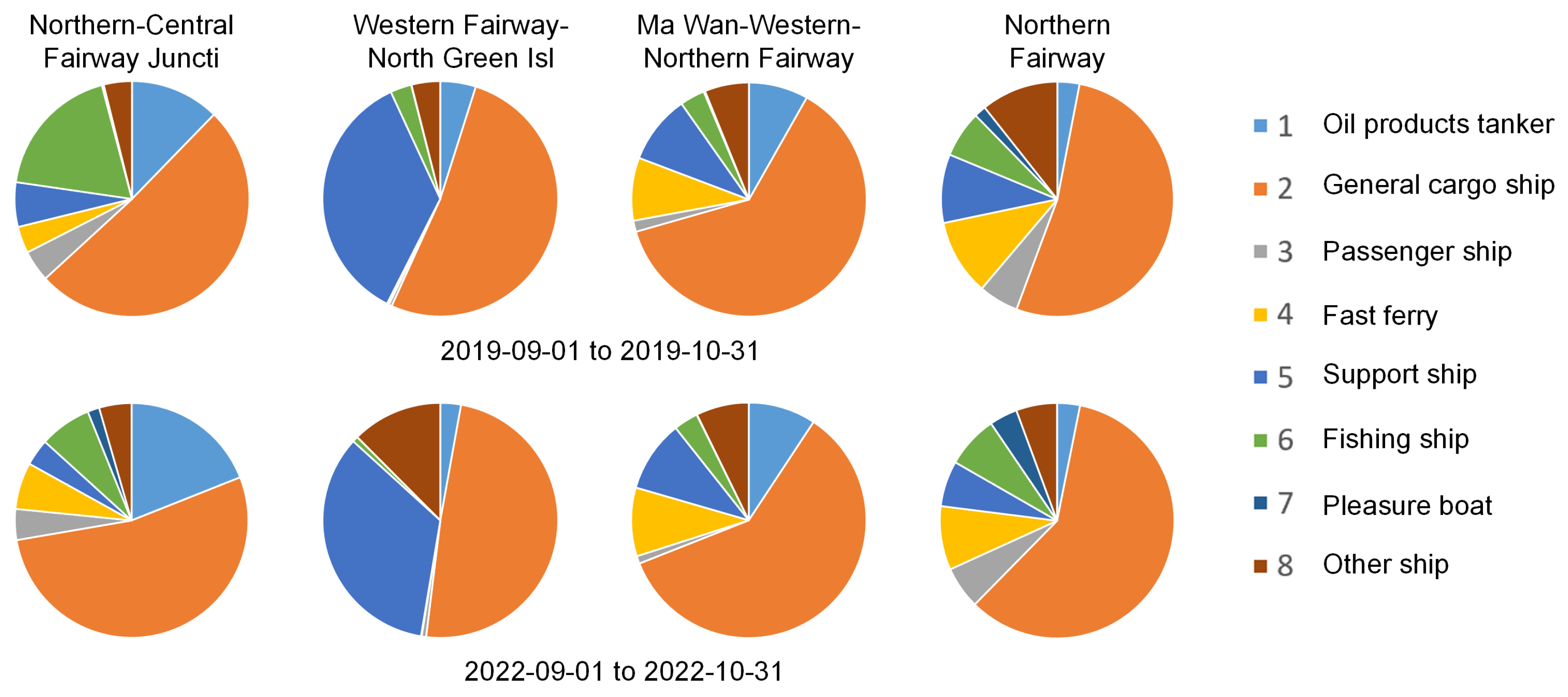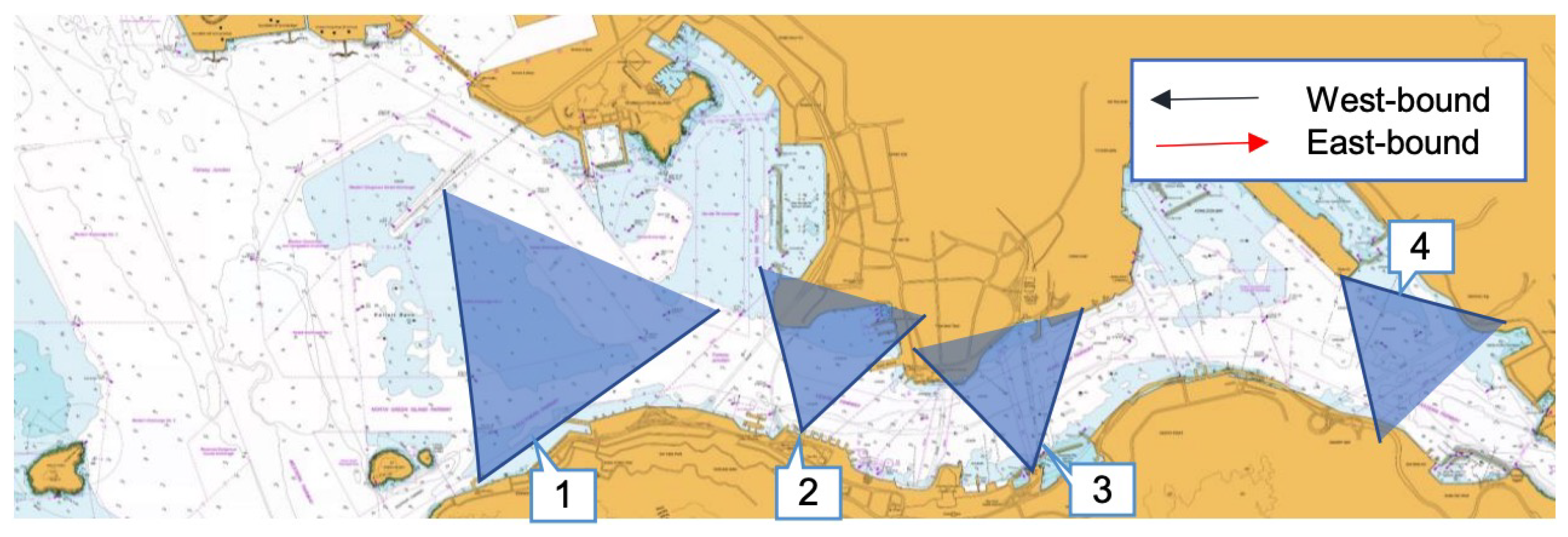Assessing the Credibility of AIS-Calculated Risks in Busy Waterways: A Case Study of Hong Kong Waters
Abstract
1. Introduction
1.1. Hong Kong Maritime Accident Cases
1.2. Motivation and Contribution
- We propose using traffic images of the study area to assess the feasibility and risk probability of a real-world waterway. Specifically, the IALA Waterway Risk Assessment Program (IWRAP) (https://www.iala.int/wiki/iwrap/index.php/Main_Page, accessed on 8 September 2025) was suggested to simulate the likelihood of a duty officer failing to respond in time during collisions with other vessels or grounding incidents.
- We propose leveraging IWRAP and AIS data to reconstruct maritime traffic flows within the study area over the data coverage period. Subsequently, we analyze ship maneuvering patterns and behaviors through transverse distribution analysis and explore causal factors to assess collision risk probabilities across various points and regions within the study area.
2. Literature Review
3. The Proposed Method
3.1. AIS Data Cleaning
3.2. AIS-Based Risk Analysis
- First, the relevant navigation area is described, which includes the description of all traffic structures along the route and all the ground near the route.
- Next, the vessel under consideration is defined as navigating a specific route within the designated navigational area. All potential striking vessels or grounding hazards, as depicted in Figure 3, are identified, and the probabilities of grounding and collision are calculated.
- Subsequently, the identified grounding hazards or striking vessels may be further analyzed to compute damage statistics.
3.3. Vision-Based Ship Detection and Tracking
3.3.1. YOLOv7-Based Ship Detection
3.3.2. DeepSORT-Based Ship Detection
4. Experiments and Discussions Through a Case Study of Hong Kong Waters
4.1. Risk Analysis of Traffic Records
4.1.1. Quantitative Analysis
4.1.2. Daily and Weekly Risk Analysis
4.1.3. Collision Risk Ratios by Vessel Types
4.1.4. Risk Levels of Central Channel Voyage Segments
- Low: Among the 144 risk values of the selected six main routes and 24 time periods, a risk ranking in the top 1/3 is defined as low risk.
- Medium: Among the 144 risk values of the selected six main routes and 24 time periods, a risk ranking in the middle 1/3 is defined as medium risk.
- High: Among the 144 risk values of the selected six main routes and 24 time periods, a risk ranking in the bottom 1/3 is defined as high risk.
4.2. Impact of Increased OGV Traffic
4.3. Traffic Records from Real-Time Observations
4.4. Discussion
5. Conclusions
Author Contributions
Funding
Data Availability Statement
Conflicts of Interest
References
- Yang, D.; Wu, L.; Wang, S.; Jia, H.; Li, K.X. How big data enriches maritime research–a critical review of Automatic Identification System (AIS) data applications. Transp. Rev. 2019, 39, 755–773. [Google Scholar] [CrossRef]
- Xiao, G.; Amamoo-Otoo, C.; Wang, T.; Li, Q.; Biancardo, S.A. Evaluating the impact of ECA policy on sulfur emissions from the five busiest ports in America based on difference in difference model. Front. Mar. Sci. 2025, 12, 1609261. [Google Scholar] [CrossRef]
- Wu, M.; Li, X.; Chen, Y. Port–Shipping Interplay: A Multi-Stage Analysis of Facility Upgrades and Cargo Movement. Mathematics 2025, 13, 1152. [Google Scholar] [CrossRef]
- Wang, T.; Xiao, G.; Li, Q.; Biancardo, S.A. The impact of the 21st-Century Maritime Silk Road on sulfur dioxide emissions in Chinese ports: Based on the difference-in-difference model. Front. Mar. Sci. 2025, 12, 1608803. [Google Scholar] [CrossRef]
- He, Z.; Zhao, P.; Zhang, S.; Li, Z.; Huang, G.; Zhang, C.; Niu, Y. Analyzing foreland dynamics in China’s port clusters under global major events (2019–2022) by AIS trajectory data. Ocean. Coast. Manag. 2024, 255, 107269. [Google Scholar] [CrossRef]
- Yang, K.; Yang, D.; Lu, Y. Enhancing risk perception by integrating ship interactions in multi-ship encounters: A Graph-based Learning method. Reliab. Eng. Syst. Saf. 2025, 261, 111150. [Google Scholar] [CrossRef]
- Lam, R.P.K.; Wong, R.T.M.; Lau, E.H.Y.; Wong, K.W.; Cheung, A.C.K.; Chaang, V.K.; Chen, L.; Tsang, T.C.; Chan, T.K.; Chee, P.P.Y.; et al. Injury patterns of mass casualty incidents involving high-speed passenger ferries presenting to accident and emergency departments in Hong Kong: A retrospective review. Injury 2020, 51, 252–259. [Google Scholar] [CrossRef]
- Wang, Y.F.; Wang, L.T.; Jiang, J.C.; Wang, J.; Yang, Z.L. Modelling ship collision risk based on the statistical analysis of historical data: A case study in Hong Kong waters. Ocean Eng. 2020, 197, 106869. [Google Scholar] [CrossRef]
- Qu, J.; Liu, R.W.; Guo, Y.; Lu, Y.; Su, J.; Li, P. Improving maritime traffic surveillance in inland waterways using the robust fusion of AIS and visual data. Ocean Eng. 2023, 275, 114198. [Google Scholar] [CrossRef]
- Guo, Y.; Liu, R.W.; Qu, J.; Lu, Y.; Zhu, F.; Lv, Y. Asynchronous trajectory matching-based multimodal maritime data fusion for vessel traffic surveillance in inland waterways. IEEE Trans. Intell. Transp. Syst. 2023, 24, 12779–12792. [Google Scholar] [CrossRef]
- Liu, R.W.; Lu, Y.; Guo, Y.; Ren, W.; Zhu, F.; Lv, Y. AiOENet: All-in-one low-visibility enhancement to improve visual perception for intelligent marine vehicles under severe weather conditions. IEEE Trans. Intell. Veh. 2023, 9, 3811–3826. [Google Scholar] [CrossRef]
- Li, L.; Xu, W.; Gao, Y.; Lu, Y.; Yang, D.; Liu, R.W.; Zhang, R. Attention-oriented residual block for real-time low-light image enhancement in smart ports. Comput. Electr. Eng. 2024, 120, 109634. [Google Scholar] [CrossRef]
- Yang, D.; Li, X.; Zhang, L. A novel vessel trajectory feature engineering for fishing vessel behavior identification. Ocean Eng. 2024, 310, 118677. [Google Scholar] [CrossRef]
- Xu, W.; Yang, D.; Gao, Y.; Lu, Y.; Zhang, J.; Guo, Y. MvKSR: Multi-view Knowledge-guided Scene Recovery for Hazy and Rainy Degradation. IEEE Trans. Instrum. Meas. 2024, 73, 5028712. [Google Scholar] [CrossRef]
- Lu, Y.; Yang, D.; Gao, Y.; Liu, R.W.; Liu, J.; Guo, Y. AoSRNet: All-in-One Scene Recovery Networks via multi-knowledge integration. Knowl.-Based Syst. 2024, 294, 111786. [Google Scholar] [CrossRef]
- Liu, R.W.; Lu, Y.; Gao, Y.; Guo, Y.; Ren, W.; Zhu, F.; Wang, F.Y. Real-Time Multi-Scene Visibility Enhancement for Promoting Navigational Safety of Vessels Under Complex Weather Conditions. IEEE Trans. Intell. Transp. Syst. 2024, 25, 19979–19994. [Google Scholar] [CrossRef]
- Lu, Y.; Yang, K.; Yang, D.; Ding, H.; Weng, J.; Liu, R.W. Graph Learning-Driven Multi-Vessel Association: Fusing Multimodal Data for Maritime Intelligence. arXiv 2025, arXiv:2504.09197. [Google Scholar] [CrossRef]
- Paté-Cornell, M.E. Organizational aspects of engineering system safety: The case of offshore platforms. Science 1990, 250, 1210–1217. [Google Scholar] [CrossRef]
- Li, S.; Meng, Q.; Qu, X. An overview of maritime waterway quantitative risk assessment models. Risk Anal. Int. J. 2012, 32, 496–512. [Google Scholar] [CrossRef] [PubMed]
- Merrick, J.R.; Van Dorp, R. Speaking the truth in maritime risk assessment. Risk Anal. Int. J. 2006, 26, 223–237. [Google Scholar] [CrossRef] [PubMed]
- Yang, X.; Haugen, S.; Li, Y. Risk influence frameworks for activity-related risk analysis during operation: A literature review. Saf. Sci. 2017, 96, 102–116. [Google Scholar] [CrossRef]
- Grabowski, M.; Merrick, J.R.; Harrold, J.; Massuchi, T.; Van Dorp, J. Risk modeling in distributed, large-scale systems. IEEE Trans. Syst. Man Cybern. Part A Syst. Hum. 2000, 30, 651–660. [Google Scholar] [CrossRef]
- Soares, C.G.; Teixeira, A. Risk assessment in maritime transportation. Reliab. Eng. Syst. Saf. 2001, 74, 299–309. [Google Scholar] [CrossRef]
- Hu, S.; Li, X.; Fang, Q.; Yang, Z. Use of Bayesian method for assessing vessel traffic risks at sea. Int. J. Inf. Technol. Decis. Making 2008, 7, 627–638. [Google Scholar] [CrossRef]
- Hänninen, M.; Kujala, P. Influences of variables on ship collision probability in a Bayesian belief network model. Reliab. Eng. Syst. Saf. 2012, 102, 27–40. [Google Scholar] [CrossRef]
- Pedersen, P.T. Review and application of ship collision and grounding analysis procedures. Mar. Struct. 2010, 23, 241–262. [Google Scholar] [CrossRef]
- Heij, C.; Bijwaard, G.E.; Knapp, S. Ship inspection strategies: Effects on maritime safety and environmental protection. Transp. Res. Part D Transp. Environ. 2011, 16, 42–48. [Google Scholar] [CrossRef]
- Goerlandt, F.; Montewka, J. Maritime transportation risk analysis: Review and analysis in light of some foundational issues. Reliab. Eng. Syst. Saf. 2015, 138, 115–134. [Google Scholar] [CrossRef]
- Goerlandt, F.; Kujala, P. On the reliability and validity of ship–ship collision risk analysis in light of different perspectives on risk. Saf. Sci. 2014, 62, 348–365. [Google Scholar] [CrossRef]
- Lim, G.J.; Cho, J.; Bora, S.; Biobaku, T.; Parsaei, H. Models and computational algorithms for maritime risk analysis: A review. Ann. Oper. Res. 2018, 271, 765–786. [Google Scholar] [CrossRef]
- Zaccone, R. A dynamic programming approach to the collision avoidance of autonomous ships. Mathematics 2024, 12, 1546. [Google Scholar] [CrossRef]
- Laine, V.; Goerlandt, F.; Baldauf, M.; Mehdi, R.; Besikçi, E.; Koldenhof, Y.; Al Quhali, M.; Backer, H. OpenRisk Guideline for Regional Risk Management to Improve European Pollution Preparedness and Response at Sea; HELCOM–Helsinki Commission: Helsinki, Finland, 2018; Volume 111. [Google Scholar]
- Mullai, A.; Paulsson, U. A grounded theory model for analysis of marine accidents. Accid. Anal. Prev. 2011, 43, 1590–1603. [Google Scholar] [CrossRef]
- Gaonkar, R.S.P.; Xie, M.; Ng, K.M.; Habibullah, M.S. Subjective operational reliability assessment of maritime transportation system. Expert Syst. Appl. 2011, 38, 13835–13846. [Google Scholar] [CrossRef]
- Liu, J.; Yang, J.B.; Wang, J.; Sii, H.S. Engineering system safety analysis and synthesis using the fuzzy rule-based evidential reasoning approach. Qual. Reliab. Eng. Int. 2005, 21, 387–411. [Google Scholar] [CrossRef]
- Montewka, J.; Hinz, T.; Kujala, P.; Matusiak, J. Probability modelling of vessel collisions. Reliab. Eng. Syst. Saf. 2010, 95, 573–589. [Google Scholar] [CrossRef]
- Kolowrocki, K.; Soszynska, J. On safety analysis of complex technical maritime transportation systems. Proc. Inst. Mech. Eng. Part O J. Risk Reliab. 2011, 225, 345–354. [Google Scholar] [CrossRef]
- Singh, S.; Singh, J.; Singh, S.; Goyal, S.; Raboaca, M.S.; Verma, C.; Suciu, G. Detection and mitigation of GNSS spoofing attacks in maritime environments using a genetic algorithm. Mathematics 2022, 10, 4097. [Google Scholar] [CrossRef]
- Tao, L.; Chen, L.; Ge, D.; Yao, Y.; Ruan, F.; Wu, J.; Yu, J. An integrated probabilistic risk assessment methodology for maritime transportation of spent nuclear fuel based on event tree and hydrodynamic model. Reliab. Eng. Syst. Saf. 2022, 227, 108726. [Google Scholar] [CrossRef]
- Yin, J. Quantitative Risk Assessment for Maritime Safety Management. Ph.D. Thesis, Hong Kong Polytechnic University, Hong Kong, China, 2011. [Google Scholar]
- Dominguez-Péry, C.; Vuddaraju, L.N.R.; Corbett-Etchevers, I.; Tassabehji, R. Reducing maritime accidents in ships by tackling human error: A bibliometric review and research agenda. J. Shipp. Trade 2021, 6, 20. [Google Scholar] [CrossRef]
- Salihoglu, E.; Beşikçi, E.B. The use of Functional Resonance Analysis Method (FRAM) in a maritime accident: A case study of Prestige. Ocean Eng. 2021, 219, 108223. [Google Scholar] [CrossRef]
- Goerlandt, F.; Kujala, P. Traffic simulation based ship collision probability modeling. Reliab. Eng. Syst. Saf. 2011, 96, 91–107. [Google Scholar] [CrossRef]
- Cozzani, V.; Gubinelli, G.; Antonioni, G.; Spadoni, G.; Zanelli, S. The assessment of risk caused by domino effect in quantitative area risk analysis. J. Hazard. Mater. 2005, 127, 14–30. [Google Scholar] [CrossRef]
- Senol, Y.E.; Aydogdu, Y.V.; Sahin, B.; Kilic, I. Fault tree analysis of chemical cargo contamination by using fuzzy approach. Expert Syst. Appl. 2015, 42, 5232–5244. [Google Scholar] [CrossRef]
- Cui, H.; Qi, H.; Zhou, J. DBN-MACTraj: Dynamic Bayesian Networks for Predicting Combinations of Long-Term Trajectories with Likelihood for Multiple Agents. Mathematics 2024, 12, 3674. [Google Scholar] [CrossRef]
- Zhang, Y.; Hu, H.; Dai, L. Real-time assessment and prediction on maritime risk state on the Arctic Route. Marit. Policy Manag. 2020, 47, 352–370. [Google Scholar] [CrossRef]
- Liu, K.; Yu, Q.; Yuan, Z.; Yang, Z.; Shu, Y. A systematic analysis for maritime accidents causation in Chinese coastal waters using machine learning approaches. Ocean Coast. Manag. 2021, 213, 105859. [Google Scholar] [CrossRef]
- Wen, X.; Xie, Y.; Jiang, L.; Pu, Z.; Ge, T. Applications of machine learning methods in traffic crash severity modelling: Current status and future directions. Transport Rev. 2021, 41, 855–879. [Google Scholar] [CrossRef]
- Yang, D.; Yang, K.; Lu, Y.; Liang, M.; Zhao, C. Graph-driven multi-vessel long-term trajectories prediction for route planning under complex waters. Ocean Engineering 2024, 313, 119511. [Google Scholar] [CrossRef]
- Riveiro, M.; Pallotta, G.; Vespe, M. Maritime anomaly detection: A review. Wiley Interdiscip. Rev. Data Min. Knowl. Discov. 2018, 8, e1266. [Google Scholar] [CrossRef]
- Uyanık, T.; Karatuğ, Ç.; Arslanoğlu, Y. Machine learning approach to ship fuel consumption: A case of container vessel. Transp. Res. Part D Transp. Environ. 2020, 84, 102389. [Google Scholar] [CrossRef]
- Jin, M.; Shi, W.; Yuen, K.F.; Xiao, Y.; Li, K.X. Oil tanker risks on the marine environment: An empirical study and policy implications. Mar. Policy 2019, 108, 103655. [Google Scholar] [CrossRef]
- Hashemi, R.R.; Le Blanc, L.A.; Rucks, C.T.; Shearry, A. A neural network for transportation safety modeling. Expert Syst. Appl. 1995, 9, 247–256. [Google Scholar] [CrossRef]
- Kulkarni, K.; Goerlandt, F.; Li, J.; Banda, O.V.; Kujala, P. Preventing shipping accidents: Past, present, and future of waterway risk management with Baltic Sea focus. Saf. Sci. 2020, 129, 104798. [Google Scholar] [CrossRef]
- Mou, J.M.; Van der Tak, C.; Ligteringen, H. Study on collision avoidance in busy waterways by using AIS data. Ocean Eng. 2010, 37, 483–490. [Google Scholar] [CrossRef]
- Yekeen, S.T.; Balogun, A.L. Advances in remote sensing technology, machine learning and deep learning for marine oil spill detection, prediction and vulnerability assessment. Remote Sens. 2020, 12, 3416. [Google Scholar] [CrossRef]
- Kretschmann, L. Leading indicators and maritime safety: Predicting future risk with a machine learning approach. J. Shipp. Trade 2020, 5, 19. [Google Scholar] [CrossRef]
- Wang, C.Y.; Bochkovskiy, A.; Liao, H.Y.M. YOLOv7: Trainable bag-of-freebies sets new state-of-the-art for real-time object detectors. In Proceedings of the 2023 IEEE/CVF Conference on Computer Vision and Pattern Recognition (CVPR), Vancouver, BC, Canada, 17–24 June 2023; pp. 7464–7475. [Google Scholar] [CrossRef]
- Chen, X.; Wei, C.; Yang, Y.; Luo, L.; Biancardo, S.A.; Mei, X. Personnel trajectory extraction from port-like videos under varied rainy interferences. IEEE Trans. Intell. Transp. Syst. 2024, 25, 6567–6579. [Google Scholar] [CrossRef]









| 2019 May–Oct | 2021 May–Oct | ||
|---|---|---|---|
| (Pre-COVID-19) | (COVID-19) | ||
| Study Area | Causation Factor | 0.2884 | 0.1405 |
| Risk Probability | 0.29 incidents/yr | 0.14 incidents/yr | |
| Central Fairway Path | Causation Factor | 0.1365 | 0.0602 |
| Risk Probability | 0.14 incidents/yr | 0.06 incidents/yr | |
| Proportion of risk | 47.32% | 42.83% |
| Study Area | 2019 Sep–Oct | 2020 Sep–Oct | 2021 Sep–Oct | 2022 Sep–Oct |
|---|---|---|---|---|
| Causation Factor | 0.2628 | 0.1548 | 0.1368 | 0.0756 |
| Risk Probability | 0.26 incidents/yr | 0.15 incidents/yr | 0.14 incidents/yr | 0.08 incidents/yr |
| Area 1 | Area 2 | Area 3 | Area 4 | |||||||||
|---|---|---|---|---|---|---|---|---|---|---|---|---|
| West | East | Total | West | East | Total | West | East | Total | West | East | Total | |
| OGV | 463 | 392 | 855 | 114 | 99 | 213 | 115 | 106 | 221 | 90 | 93 | 184 |
| Ferry | 1197 | 1249 | 2446 | 453 | 437 | 890 | 127 | 147 | 274 | 194 | 189 | 383 |
| Local Vessel | 2675 | 2705 | 5380 | 3199 | 3157 | 6356 | 2286 | 2213 | 4499 | 1867 | 2004 | 3870 |
| Total | 4335 | 4346 | 8681 | 3766 | 3693 | 7459 | 2528 | 2466 | 5094 | 2151 | 2286 | 4437 |
Disclaimer/Publisher’s Note: The statements, opinions and data contained in all publications are solely those of the individual author(s) and contributor(s) and not of MDPI and/or the editor(s). MDPI and/or the editor(s) disclaim responsibility for any injury to people or property resulting from any ideas, methods, instructions or products referred to in the content. |
© 2025 by the authors. Licensee MDPI, Basel, Switzerland. This article is an open access article distributed under the terms and conditions of the Creative Commons Attribution (CC BY) license (https://creativecommons.org/licenses/by/4.0/).
Share and Cite
Jiang, Y.; Xu, W.; Yang, D. Assessing the Credibility of AIS-Calculated Risks in Busy Waterways: A Case Study of Hong Kong Waters. Mathematics 2025, 13, 2961. https://doi.org/10.3390/math13182961
Jiang Y, Xu W, Yang D. Assessing the Credibility of AIS-Calculated Risks in Busy Waterways: A Case Study of Hong Kong Waters. Mathematics. 2025; 13(18):2961. https://doi.org/10.3390/math13182961
Chicago/Turabian StyleJiang, Yao, Wenyu Xu, and Dong Yang. 2025. "Assessing the Credibility of AIS-Calculated Risks in Busy Waterways: A Case Study of Hong Kong Waters" Mathematics 13, no. 18: 2961. https://doi.org/10.3390/math13182961
APA StyleJiang, Y., Xu, W., & Yang, D. (2025). Assessing the Credibility of AIS-Calculated Risks in Busy Waterways: A Case Study of Hong Kong Waters. Mathematics, 13(18), 2961. https://doi.org/10.3390/math13182961





